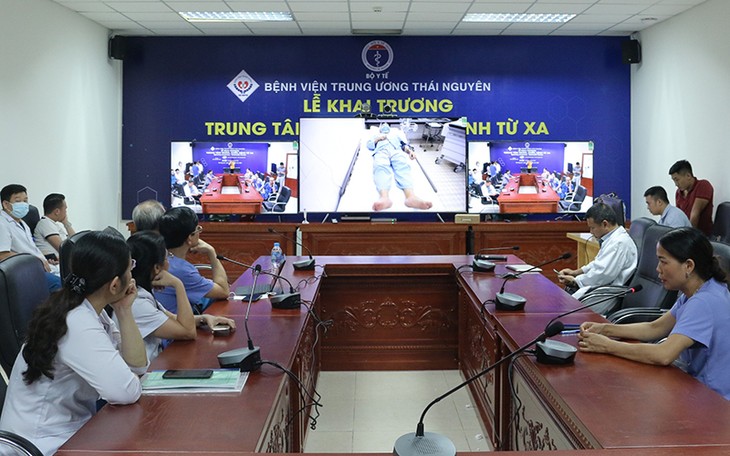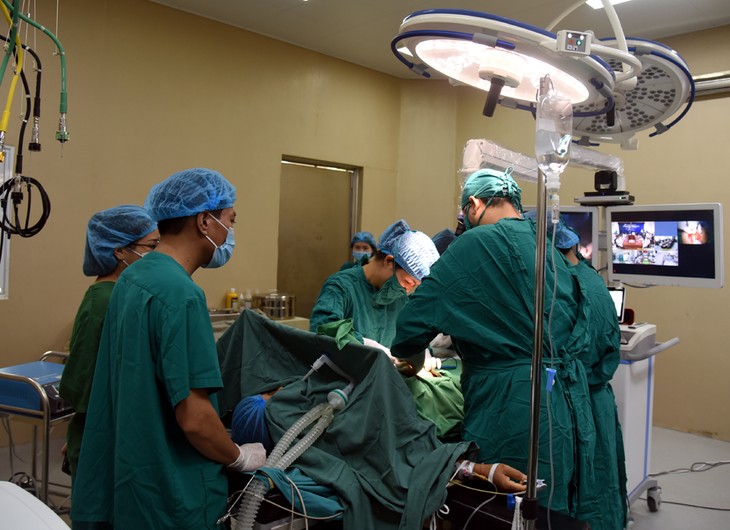(VOVWORLD) - The Health Ministry’s ongoing telehealth project has helped people in remote isolated areas access quality health care services. Using IT and modern medical equipment, doctors at upper-level hospitals can remotely examine and diagnose people in their home or at medical stations at the grassroots level.
 An online medical consultation of Thai Nguyen Central General Hospital with hospitals at the lower level. (Photo: nhandan.com.vn) An online medical consultation of Thai Nguyen Central General Hospital with hospitals at the lower level. (Photo: nhandan.com.vn) |
An online medical consultation was held recently between doctors at Thai Nguyen Central General Hospital and Vo Nhai District General Hospital.
After studying medical reports and medical imaging results online, the central-level doctors helped their district-level peers successfully treat an 80-year-old patient who was suffering from angina attacks.
Doctor Le Hung Vuong, Head of the Active Rehabilitation and Anti-poisoning Department of Thai Nguyen Central General Hospital, said, “It’s extremely important for patients in critical condition to be intervened during the ‘golden time’. Rendering emergency aid just a few seconds or a minute earlier can be decisive to the patient’s survival. In the case of patients who need mechanical ventilation, we can instruct local colleagues via cameras connected to the hospital bed.”
“This method often eliminates the need to transfer a patient to a higher-level hospital, or enables doctors at the lower level to handle the patient properly before transferring them to another hospital,” said Vuong.
Online diagnosis conferences are one effective way to help grassroots-level health facilities treat patients with severe conditions.
Specialist Level 2 Doctor Nguyen Chi Cuong, Head of the Obstetrics Department of Thai Nguyen Central General Hospital, said, “Online training is very effective because many people can join the session at the same time. In the past, we had to send doctors to assist local hospitals if there was a severely ill patient. Now we can quickly provide remote professional consultation. Recently, thanks to remote assistance, two pregnant women bleeding during a cesarean section were saved.”
Associate Professor Dr. Nguyen Cong Hoang, Director of Thai Nguyen Central General Hospital, said, “Using high tech to enable remote medical examination and treatment has had many benefits, including reducing travel time for doctors and keeping doctors updated on new techniques. People are happy to be treated by doctors at central hospitals without having to visit them in person.”
|
 An operation at Bac Kan General Hospital with the direct consultation of doctors of An operation at Bac Kan General Hospital with the direct consultation of doctors of
Thai Nguyen Hospital. (Photo: baobackan.org.vn)
|
It costs a district hospital just 2,200 USD to install a telehealth system that will enable it to connect to any central hospital.
Already, 190 provincial and district hospitals have joined the remote examination and treatment network of Hanoi Medical University Hospital.
Doctor Phuc Duc Sam, Deputy Director of the General Hospital of Dinh Hoa district in Thai Nguyen province, said, “Our target is to connect our telehealth system to the national network in the first quarter of 2021. We’ve registered with Bach Mai Hospital and Hanoi Medical University Hospital. We’ve already started following online consultation sessions held by teacher doctors at those hospitals.”
According to Minister of Health Nguyen Thanh Long, one of the goals of its project is to have each doctor at the central level provide professional training to 4 doctors at the provincial level, 4 doctors at the district level, and 2 doctors at the communal level.
Minister Long told VOV that the Ministry’s overall goal is the satisfaction of patients’ needs through better medical examination and treatment.
“For medical workers, training is an ongoing need at all levels. We have high hopes in this project to have upper-level hospitals train hospitals at lower levels and provide emergency support to lower-level hospitals as needed. This is the modern trend in medicine,” said Minister Long.
Telehealth eliminates geographical difficulties, reduces overcrowding at higher-level hospitals, improves patient care at lower levels, and helps meet national goals for epidemic prevention and socio-economic development.